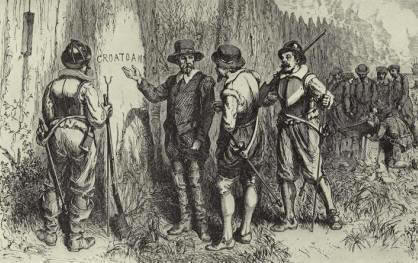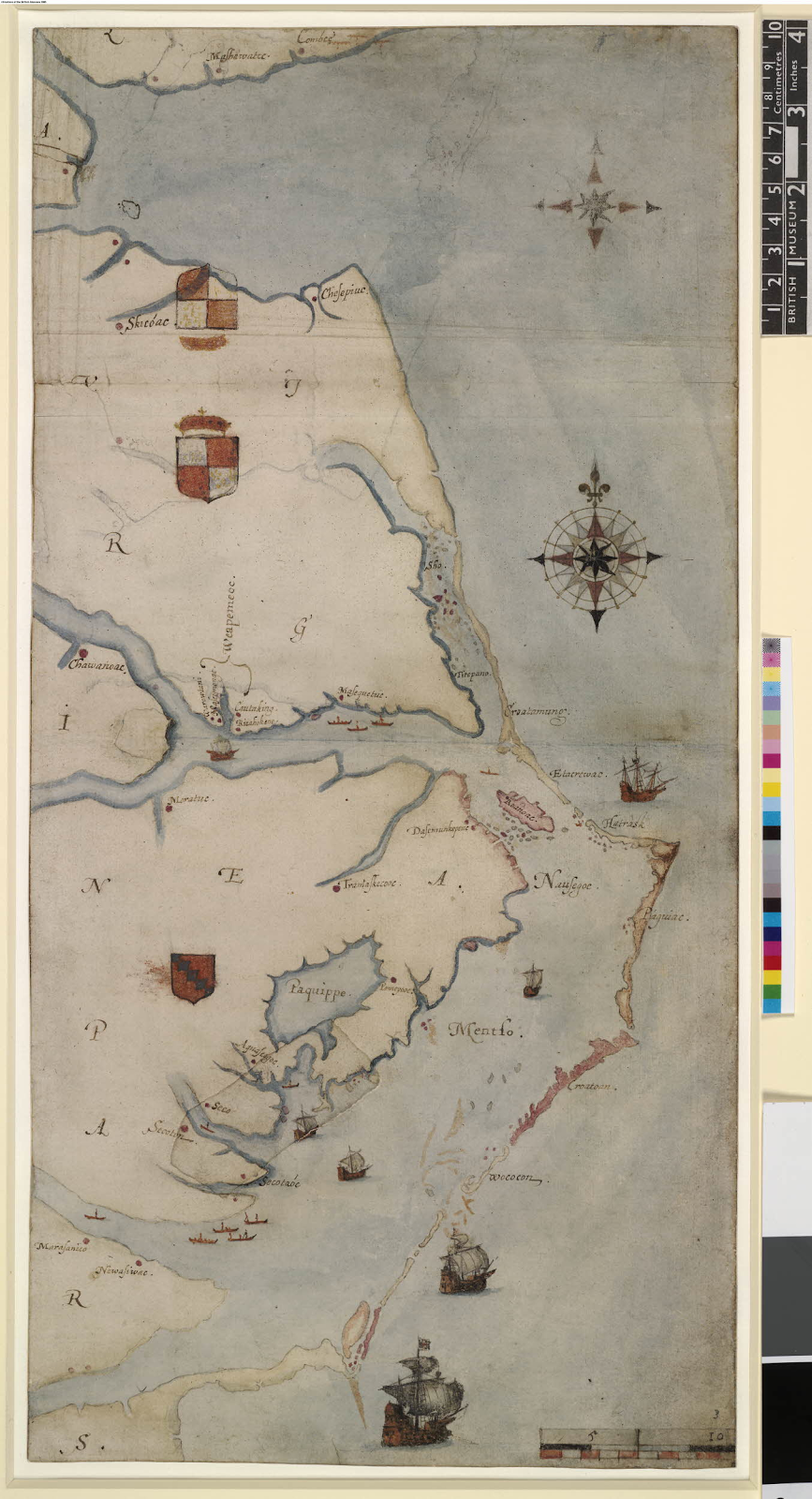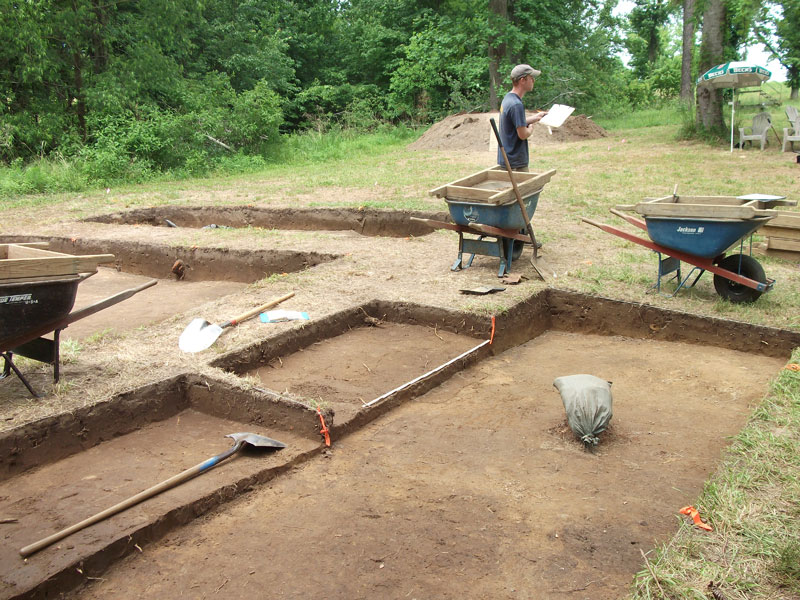|
The details of the stories and histories of the first American colonies may or may not be familiar depending on how much American history you have consumed since high school. It is well known that the Pilgrims settled Plymouth Colony after arriving on the Mayflower and that the Puritans came to Massachusetts for religious freedom. The real intrigue of Colonial America lies in the mysterious fate of the settlers of Roanoke Colony who disappeared in 1590. How much do we know from historical accounts? In history and in archaeology, how do you begin to search for something that is lost? What evidence do we need to determine the fate of those that disappeared over 400 years ago? Even for historical time periods, examination of relevant archaeological evidence can confirm or call into question certain events. Textbooks give the impression that history is decided fact but historical records are often written from a certain perspective that can gloss over details or ignore certain groups. An ongoing conversation between historians, archaeologists, and the public is vital to a holistic understanding of the American past. Archaeology can be a valuable learning tool and offer new perspectives of the past in both formal and informal education. In addition to participating in the conversation, interested members of the public can also gain first hand experience in uncovering American history by helping with the excavation process. Both The Lost Colony Center and The First Colony Foundation utilize volunteers at the Cape Creek site and Site X respectively, which as we will see, are two potential sites for the Roanoke resettlement. What we do know is that in 1587, on orders from Queen Elizabeth I, Sir Walter Raleigh set out for Chesapeake Bay but was forced to disembark on Roanoke Island, off the present day coast of North Carolina. Two previous groups had explored the island and the second was driven out by local Native Americans, such as the Secotan tribe, angry by colonists’ intention to use the land and resources. After John White was appointed governor of Roanoke by Raleigh he returned to England for much needed relief supplies. The colonists had arrived to the island to find less than friendly locals and research now indicates the area was in the middle of a severe drought. After the Spanish Armada delayed his journey back to Roanoke, White finally returned on August 18, 1590 and found the settlement completely abandoned. Approximately 115 men, women and children had disappeared. The Roanoke Colony settlers left behind the word “Croatoan” carved on a prominent post and the letters “Cro” etched into a tree. Since then, theories abound as to the fate of the settlers. Many believe they left due to starvation,disease or even violence, but why and where did they go? Historical archaeology is the archaeology that concerns the time periods or societies for which we do have something of a written record. In historical archaeology, the written record can contextualize the material culture found from excavation.In the case of Roanoke, it can tell us where to dig. There is not a historical evidence when it comes to the lost colony but what there is lends itself to, as of now, two possibilities for the fate of colonists. The obvious historical clue is the word “Croatoan”, carved into the post at the site of abandonment. Croatoan is the name of a small tribe of Native Americans that lived in the Carolinas at the time. White initially had plans to sail south to Croatoan (now Hatteras) Island when he first discovered Roanoke abandoned but a storm delayed the voyage and then the privateers he was traveling with insisted on returning to England. Cape Creek on Hatteras Island (also off the coast of North Carolina) is a confirmed site of a major town and trade hub of the Croatoan, and is only 50 miles southeast of Roanoke. Excavations on Hatteras Island have yielded both Native American and European artifacts, which some archaeologists see as evidence of Roanoke settler presence. So far excavations have turned up deer and turtle bones, pieces of European iron, Native American pottery, a slate writing tablet, parts of a 16th century gun, and even a gold signet ring probably worn by an English nobleman. Some of these European artifacts, like a writing tablet, are not valuable trade items and may be evidence of cohabitation, however, some of the goods date to the mid 17th century, about 50 years after the lost colonists would have presumably resettled. If this new archaeological evidence is an indication of the Roanoke colonists’ presence at Hatteras Island it is unlikely that they all relocated with the Croatoan. If their number was nearly 115 (assuming not a significant amount died from lack of resources or other fates before attempted resettlement), a procedure established by previous groups in the colonies dictated that they split up – it is highly unlikely that other settlements could support an additional 115 people. Once again, historical evidence tells us about a possible location for resettlement.
New evidence from this inland site has also come from ground penetrating radar (GPR). GPR is a technology employed by archaeologists to visualize and map possible objects below ground. It sends radio waves into the ground and measures the echo from the signal that bounces off buried objects. For example, GPR has been used to identify coffins since the coffins contain voids with poorer conductive properties and different densities than the soil around them. When testing this possible Roanoke settler site, researchers at Elizabeth City State University in North Carolina found a pattern that may indicate structures, possibly those made of wood, about 3 feet down. While the GPR evidence may indicate a colonial presence at the site, these results are complicated by the fact that there are known English settlements in the area through the 1700s. Right now, it is impossible to know whether the buried structure belonged to the Roanoke settlers or a later group. Excavation and non-invasive techniques like GPR are only part of the archaeological process. It is vital to contextualize what we find or do not find in the ground. Brett Riggs, an archaeologist at University of North Carolina – Chapel Hill cautions against equating European artifacts with European presence. He notes that Native Americans often scavenged anything left by Europeans. Additionally there are issues with dating some of these artifacts precisely and 50 years either way could rule out the possibility of Roanoke settlers, if any Europeans were indeed living on Hatteras Island or at Site X. Stylistic changes are not uniform over time or space so it is difficult to date things like pottery reliably and radiocarbon dating is not precise enough for decade by decade measurements. It is possible that we may never completely solve the mystery of Roanoke’s disappearing settlers. However, by pairing historical evidence with archaeological investigation that includes new technologies like GPR we can better examine that contentious time in American history. Archaeologists associated with both projects note that there is still more to dig, and more to discover. Even for historical time periods, examination of relevant archaeological evidence can confirm or call into question certain events. Textbooks give the impression that history is decided fact but historical records are often written from a certain perspective that can gloss over details or ignore certain groups. An ongoing conversation between historians, archaeologists, and the public is vital to a holistic understanding of the American past. Archaeology can be a valuable learning tool and offer new perspectives of the past in both formal and informal education. In addition to participating in the conversation, interested members of the public can also gain first hand experience in uncovering American history by helping with the excavation process. Both The Lost Colony Center and The First Colony Foundation utilize volunteers at the Cape Creek site and Site X respectively. In 2007, The Lost Colony Center launched another project that highlights the importance of advanced techniques in archaeology and community outreach. They are attempting to use DNA to find genetic links between living descendants and colonists and local Native Americans like the Hatteras. Using historical sources researchers at the center compiled a list of ‘most wanted’ last names to sample in the hopes of matching DNA from skeletal remains to living ancestors. The project is still ongoing, with a goal collection of 500 samples before sequencing DNA from the archaeological remains begins. If you are interested in volunteering or learning more about archaeological projects investigating colonial America, you can visit the websites of The Lost Colony Center and The First Colony Foundation, listed below. References Basu, T. (8 December 2013). Have We Found the Lost Colony of Roanoke Island? “National Geographic.” First Colony Foundation. (10 August 2015). Testing Continues at Site X. www.firstcolonyfoundation.org. Lawler, A. (7 August 2015). We Finally Have Clues to How the Lost Roanoke Colony Vanished. “National Geographic.” Morrison, J. In Search of the Lost Colony. American Archaeology, 10(4), 2006-2007. Stahle, D. W., Cleaveland, M. K., Blanton, D. B., Therrell, M. D., & Gay, D. A. (1998). The lost colony and Jamestown droughts. Science, 280(5363), 564-567. About the author: Emily Brennan has her M.A. in anthropology, emphasis in archaeology and biological anthropology, and has participated in excavations in Romania and the UK. She currently works in biomedical research support and her passion for science education led to the creation of the blog Grave Thoughts (www.gravethoughtsblog.wordpress.com).
2 Comments
Bruce P
7/2/2022 08:54:47 am
Fascinating subject. As technology for locating and dating historically important objects continues to improve, we will advance our knowledge.
Reply
jk
12/8/2023 06:36:23 am
hi
Reply
Leave a Reply. |
|



